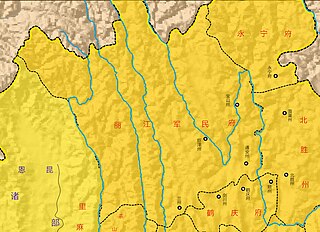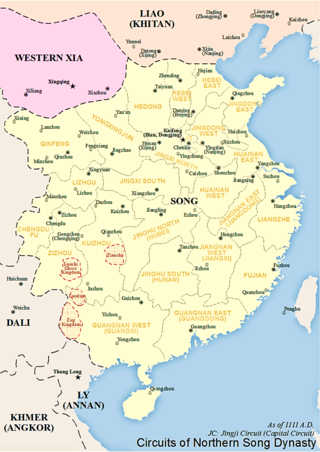
Tusi, often translated as "headmen" or "chieftains", were hereditary tribal leaders recognized as imperial officials by the Yuan, Ming, and Qing dynasties of China, and the Later Lê and Nguyễn dynasties of Vietnam. They ruled certain ethnic minorities in central China, western China, southwestern China, and the Indochinese peninsula nominally on behalf of the central government. As succession to the Tusi position was hereditary, these regimes effectively formed numerous autonomous petty dynasties under the suzerainty of the central court. This arrangement is known as the Tusi System or the Native Chieftain System. It should not to be confused with the Chinese tributary system or the Jimi system.

Jinchuan County is a county in the northwest of Sichuan Province, China. It is under the administration of the Ngawa Tibetan and Qiang Autonomous Prefecture. The seat of county is Jinchuan Town (Rabden).

Tibet under Mongol rule refers to the Mongol Empire and Yuan dynasty's rule over Tibet from 1244 to 1354. During the Yuan dynasty rule of Tibet, the region was structurally, militarily and administratively controlled by the Mongol-led Yuan dynasty of China. In the history of Tibet, Mongol rule was established after Sakya Pandita got power in Tibet from the Mongols in 1244, following the 1240 Mongol conquest of Tibet led by the Mongol general with the title doord darkhan. It is also called the Sakya dynasty after the favored Sakya school of Tibetan Buddhism.

The Chiefdom of Lijiang was a Nakhi autonomous Tusi chiefdom that ruled Lijiang during Yuan, Ming and Qing dynasty.
Sonom was a chieftain of the rGyalrong people in China. He was the lord-lama of Greater Jinchuan. He was executed after his January 1776 defeat in the Jinchuan campaigns.

The Bureau of Buddhist and Tibetan Affairs, or Xuanzheng Yuan was a government agency of the Mongol-led Yuan dynasty of China to handle Buddhist affairs across the empire in addition to managing the territory of Tibet. It was originally set up by Kublai Khan in 1264 under the name Zongzhi Yuan or the "Bureau of General Regulation", before it was renamed in 1288.

The Chiefdom of Bozhou, ruled by the Yang clan, was an autonomous Tusi chiefdom established by Yang Duan (楊端) during the Tang dynasty. After he conquered the Bozhou Prefecture from the Nanzhao Kingdom, Yang Duan was recognized as the hereditary ruler of the region by the Tang court in 876.
The Tangya Tusi Fortress is located in Tangya Town, Xianfeng County, Hubei Province, China. It is one of the three Tusi Sites designated by the UNESCO as a World Heritage Site, On July 3, 2015. The site is the historic capital of Qin clan Tusi of Tangya, the Qin clan were the rulers of the Tangya Tusi and hereditarily governed a territory of 600 square kilometres (230 sq mi) for four centuries in the modern-day Xianfeng County. As the capital, the site was built in 1355 and abandoned in 1755.

Kingdom of Chakla or Chala was a kingdom in the Tibetan region of Kham.

The Jinchuan campaigns, also known as the Suppression of the Jinchuan Hill Peoples, were two wars between Qing Empire and the rebel forces of Gyalrong chieftains ("Tusi") from the Jinchuan region. The first campaign against Chiefdom of Chuchen happened in 1747 when the Tusi of Greater Jinchuan Slob Dpon attacked the Chiefdom of Chakla (Mingzheng). The Qianlong Emperor decided to mobilize forces and suppress Slob Dpon, who surrendered to the central government in 1749. The second campaign against Chiefdom of Tsanlha took place in 1771, when the Jinchuan Tusi Sonom killed Gebushiza Tusi of Ngawa County in Sichuan Province. After Sonom killed Gebushiza Tusi, he helped Tusi of Lesser Jinchuan, Skal bzang, to occupy the lands belonging to the other Tusi in the region. The provincial government ordered Sonom to return lands and accept the trial at the Ministry of Justice immediately. Sonom refused to retreat his rebels. The Qianlong Emperor was furious and gathered 80,000 troops and entered Jinchuan. In 1776, Qing troops sieged the castle of Sonom to force his surrender.
Chiefdom of Tsanlha, also known as Chiefdom of Lesser Jinchuan, was an autonomous Gyalrong chiefdom that ruled Lesser Jinchuan during Qing dynasty. The rulers of Tsanlha used the royal title Tsanlha Gyalpo.
Chiefdom of Bathang, or Chiefdom of Batang, was an autonomous Tusi chiefdom that ruled Bathang during the Qing dynasty period.
Chiefdom of Lithang, or Chiefdom of Litang, was an autonomous Tusi chiefdom that ruled Litang during the Qing dynasty period. Lithang, Bathang, Chakla and Derge were called the "Four Great Native Chiefdoms in Kham" (康区四大土司) by the Chinese.
Chiefdom of Yongning was a Mosuo autonomous Tusi chiefdom during the Ming and Qing dynasties. The chiefdom was located at present-day Ninglang Yi Autonomous County at the convergence of Yunnan, Sichuan and Tibet.
Chiefdom of Yao'an, ruled by the Gao clan, was a Bai autonomous Tusi chiefdom during Yuan, Ming and Qing dynasty. The chiefdom located at the convergence of Yunnan and Sichuan.
Chiefdom of Shuidong, ruled by the Song clan, was an autonomous Tusi chiefdom established by Song Jingyang (宋景陽) during the Song dynasty. After he conquered the Manzhou Prefecture from the Yi people, Song Jingyang was recognized as the hereditary ruler of the region by the Song court in 975.

Chiefdom of Sizhou, ruled by the Tian clan, was an autonomous Tusi chiefdom established by Tian Zongxian (田宗顯) during the Sui dynasty. After he conquered the Qianzhong area, Tian Zongxian was recognized as the hereditary ruler of the region by the Sui court in 582.
Gyalrong people, also called Jiarong, rGyalrong, are speakers of the Qiangic Gyalrong language who live in the southern part of Ngawa Tibetan and Qiang Autonomous Prefecture of Sichuan, China. They are also found in Danba County of Garze Prefecture. The word Gyalrong is an exo-ethnonym and loanword from the Tibetan word rGyal-mo tsha-wa rong.
覃 is a Chinese surname that can be pronounced in Mandarin as Tán or Qín, with the latter being common among Zhuang people. A 2013 study found it to be the 96th most common surname, shared by 2,400,000 people or 0.180% of the population, with the province-level unit with the most being the Guangxi Zhuang Autonomous Region.

The Chiefdom of Mengmao, officially Mengmao Anfusi (猛卯安撫司) was a Dai autonomous Tusi chiefdom in the west of Yunnan, China from 1611 to 1955.








